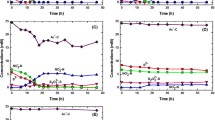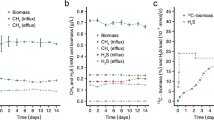Abstract
The syntrophic propionate-oxidizing bacterium MPOB was able to grow in the absence of methanogens by coupling the oxidation of propionate to the reduction of sulfate. Growth on propionate plus sulfate was very slow (μ=0.024 day−1). An average growth yield was found of 1.5 g (dry weight) per mol of propionate. MPOB grew even slower than other sulfate-reducing syntrophic propionate-oxidizing bacteria. The growth rates and yields of strict sulfate-reducing bacteria (Desulfobulbus sp.) grown on propionate plus sulfate are considerably higher.
Similar content being viewed by others
References
Amos DA & McInerney MJ (1990) Growth ofSyntrophomonas wolfei on unsaturated short chain fatty acids. Arch. Microbiol. 154: 31–36
Beaty PS & McInerney MJ (1987) Growth ofSyntrophomonas wolfei in pure culture on crotonate. Arch. Microbiol. 147: 389–393
Boone DR & Bryant MP (1980) Propionate-degrading bacterium,Syntrophobacter wolinii sp. nov. gen. nov., from methanogenic ecosystems. Appl. Environ. Microbiol. 40: 626–632
Bradford MM (1976) A rapid and sensitive method for the quantitation of microgram quantities of protein utilizing the principle of protein-dye binding. Anal. Biochem. 72: 248–254
Dong X, Cheng G & Stams AJM (1994) Butyrate oxidation bySyntrophospora bryantii in co-culture with different methanogens and in pure culture with pentenoate as electron acceptor. Appl. Microbiol. Biotechnol. 42: 647–652
Dörner C (1992) Biochemie und Energetik der Wasserstoff-Freisetzung in der syntrophen Vergärung von Fettsäuren und Benzoat. Dissertation, University of Tubingen
Harmsen HJM, Wullings B, Akkermans ADL, Ludwig W & Stams AJM (1993) Phylogenetic analysis ofSyntrophobacter wolinii reveals a relationship with sulfate-reducing bacteria. Arch. Microbiol. 160: 238–240
Harmsen HJM, Kengen HMP, Akkermans ADL & Stams AJM (1995) Phylogenetic analysis of two syntrophic propionate-oxidizing bacteria in enrichment cultures. Syst. Appl. Microbiol. 18: 67–73
Laanbroek HJ, Abee T & Voogd IL (1982) Alcohol conversions byDesulfobulbus propionicus Lindhorst in the presence and absence of sulphate and hydrogen. Arch. Microbiol. 133: 178–184
Laanbroek HJ, Geerligs HJ, Sijtsma L & Veldkamp H (1984) Competition for sulfate amongDesulfobacter, Desulfobulbus, andDesulfovibrio spp. isolated from intertidal sediments. Appl. Environ. Microbiol. 47: 329–334
McInerney MJ, Amos DA, Kealy KS & Palmer JA (1992) Synthesis and function of polyhydroxyalkanoates in anaerobic syntrophic bacteria. FEMS Microbiol. Rev. 103: 195–205
Oude Elferink SJWH, Visser A, Hulshoff Pol LW & Stams AJM (1994) Sulfate reduction in methanogenic bioreactors. FEMS Microbiol. Rev. 15: 119–136
Samain E, Dubourguier HC & Albagnac G (1984) Isolation and characterization ofDesulfobulbus elongatus sp. nov. from a mesophilic industrial digester. Syst. Appl. Microbiol. 5: 391–401
Schink B (1992) Syntrophism among prokaryotes. In: Balows A, Trüper HG, Dworkin M, Harder W & Schleifer KH (Eds) The Prokaryotes (pp 276–299.) Springer Verlag, New York
Stams AJM (1994) Metabolic interactions between anaerobic bacteria in methanogenic environments. Antonie van Leeuwenhoek 66: 271–294
Stams AJM, Kremer DR, Nicolay K, Weenk GH & Hansen TA (1984) Pathway of propionate formation inDesulfobulbus propionicus. Arch. Microbiol. 139: 167–173
Stams AJM, Van Dijk JB, Dijkema C & Plugge CM (1993) Growth of syntrophic propionate-oxidizing bacteria with fumarate in the absence of methanogenic bacteria. Appl. Environ. Microbiol. 59: 1114–1119
Thauer RK & Morris JG (1984) Metabolism of chemotrophic anaerobes: old views and new aspects. In: Kelly DP & Carr NG (Eds) The microbe 1984: part 2. Prokaryotes and eukaryotes (pp 123–168). Cambridge University Press, Cambridge
Trüper HG & Schlegel HG (1964) Sulphur metabolism in Thiorhodaceae. I. Quantitative measurements of growing cells ofChromatium okenii. Antonie van Leeuwenhoek 30: 225–238
Visser A, Beeksma I, van der Zee F, Stams AJM & Lettinga G (1993) Anaerobic degradation of volatile fatty acids at different sulphate concentrations. Appl. Microbiol. Biotechnol. 40: 549–556
Wallrabenstein C, Hauschild E & Schink B (1994) Pure culture and cytological properties ofSyntrophobacter wolinii. FEMS Microbiol. Lett. 123: 249–254
Widdel F & Hansen TA (1992) The dissimilatory sulfate-reducing and sulfur-reducing bacteria. In: Balows A, Trüper HG, Dworkin M, Harder W & Schleifer KH (Eds) The Prokaryotes (pp 583–624). Springer Verlag, New York
Widdel F & Pfennig N (1982) Studies on dissimilatory sulfate-reducing bacteria that decompose fatty acids. II. Incomplete oxidation of propionate byDesulfobulbus propionicus gen. nov. sp. nov. Arch. Microbiol. 131: 360–365
Wu W-M, Jain MK, Conway de Macario E, Thiele JH & Zeikus JG (1992) Microbial composition and characterization of prevalent methanogens and acetogens isolated from syntrophic methanogenic granules. Appl. Microbiol. Biotechnol. 38:282–290
Zhao H, Yang D, Woese CR & Bryant MP (1990) Assignment ofClostridium bryantii toSyntrophospora bryantii gen. nov., comb. nov. on the basis of a 16SrRNA sequence analysis of its crotonategrown pure culture. Int. J. Syst. Bacteriol. 40: 40–44
Author information
Authors and Affiliations
Rights and permissions
About this article
Cite this article
Van Kuijk, B.L.M., Stams, A.J.M. Sulfate reduction by a syntrophic propionate-oxidizing bacterium. Antonie van Leeuwenhoek 68, 293–296 (1995). https://doi.org/10.1007/BF00874139
Accepted:
Issue Date:
DOI: https://doi.org/10.1007/BF00874139




